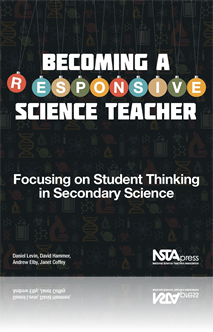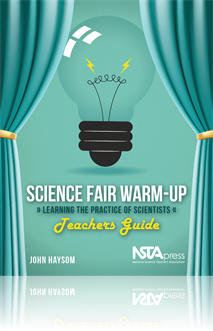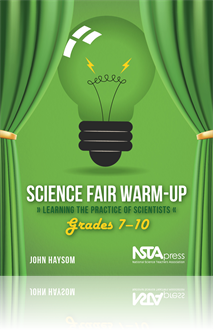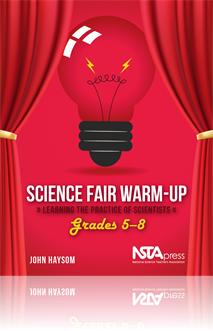All Book Chapters
Book Chapter
Evolutionary Relationships in Mammals (Genetics and Evolution)
The purpose of this chapter is to help students understand how modern phylogenetic systematics (i.e., the classification based on evolutionary history) is based on cladistics analysis. This activity also gives students an opportunity to create a clad...
Book Chapter
Decline in Saltwater Fish Populations (Ecology and Human Impact on the Environment)
The purpose of this chapter is to help students understand the factors influencing the survival of organisms in an environment, focusing on the interdependent relationships in an ecosystem. It calls attention to the limitations of our resources and t...
Book Chapter
History Of Life On Earth (Trends In Evolution)
The purpose of this activity is to help students understand the diversification and extinction of species within families during the history of life on Earth. This activity also helps students learn how to engage in practices such as using mathematic...
Book Chapter
Surviving Winter in the Dust Bowl (Food Chains and Trophic Levels)
The purpose of this activity is to help students understand food chains, the interactions between trophic levels, the interdependency of organisms, and how energy flows through a system. This activity also helps students learn how to engage in practi...
Book Chapter
Assessments and Student Samples
This Assessment chapter is meant to help teachers identify the components of an argument in students’ work and how to use the rubric to provide feedback and grading. Student samples are provided and identified as high, medium, and low based on qual...
Book Chapter
The Need for Responsive Teaching
"Responsive teaching" means something that goes beyond the images of teachers presenting information or crafting experiences, to teachers really focusing attention on student thinking. It is closely connected to assessment, not just in the sense of e...
Book Chapter
The Refinement of Everyday Thinking
This chapter is in two parts and has two interwoven purposes. The first part focuses on everyday thinking, dividing discussion into sections—“Everyday Knowledge” and “Everyday Reasoning.” The purpose here is to talk more about science and s...
Book Chapter
This chapter provides a brief overview of the set of cases and provides four suggestions—temper the impulse to evaluate the teacher; focus on understanding the students’ thinking as inquiry; support interpretations with specific evidence from the...
Book Chapter
This chapter presents the first in a pair of cases about classes on the same topic—a question developed by Izzy Kovach, one of the more experienced teachers. She found an article about a "novel commensalism" wherein live, blind snakes live unharmed...
Book Chapter
This book of case studies came from the final year of a three-year research collaboration among a team of teachers and project staff entitled What Influences Teachers’ Modifications of Curriculum? (National Science Foundation ESI 0455711). The cas...
Book Chapter
The Rime of the Ancient Mariner
This case study documents what happened in Jenny Tamper's 10th-grade biology class when she showed her students a stanza from Samuel Taylor Coleridge's poem "The Rime of the Ancient Mariner," and asked them to explain what they thought it was describ...
Book Chapter
Ninth grade students at two different schools worked on the same conceptual questions about freely falling objects. This chapter presents the first of two case studies about what happened. In this case study, Matt Reese analyzes his students' written...
Book Chapter
This case study describes what happened in David Hovan's ninth grade "Conceptual Physics" class when he asked students to answer the conceptual question set introduced in the previous chapter. He then brought the class together to discuss their respo...
Book Chapter
This book provides materials to support practices of learning to attend to student thinking, in classroom discussions and in student work. It serves to highlight some of the things to recognize in students’ thinking, both in terms of progress towar...
Book Chapter
Variables And Their Controls: Isolating Variables: Reducing Complexity
Determining the best hull design is a challenging problem. Scientists proceed systematically about designing a hull that minimizes water resistance. Drawing on their experience, they would probably begin by trying to make a list of all the factors (v...
Book Chapter
This chapter presents 15 Starting Points—some address physics, some chemistry, and others biology, while some have an engineering flavor. All students, regardless of whether or not they have previously experienced a science fair, are invited to cho...
Book Chapter
An Overview of the Nature of Scientific Inquiry
There are many possible answers to the question, "What is the nature of science and scientific inquiry?" This chapter provides students with experiences through which they can understand what science is all about and the sort of demands a scientific ...
Book Chapter
Scientific inquiry often proceeds qualitatively, especially at the early stages of an exploration into a new phenomenon. The scientists' goal seems to be to map what they perceive to be the significant features of the phenomenon, with a view to sorti...
Book Chapter
Have you ever asked yourself why scientists use numbers? It's an intriguing question. This chapter, which introduces the numbers game, highlights some of the reasons since there are many and they are interrelated. The activities in this chapter will...
Book Chapter
From an early age, children have a good idea of what being fair means. In a fair test, everything is treated in the same way (controlled), apart from that which is deliberately changed or varied. In this way, scientists can determine whether a change...
Book Chapter
Students often assume that tests are fair and their experiments are well controlled. This chapter introduces students to the idea of repeatability—the test of a fair test. Repeatability is an important cornerstone of scientific exploration. The cha...
Book Chapter
This chapter is about being accurate and being sure. It is about errors—recognizing them, taking account of them, and eliminating them. The chapter is designed to help students become aware of and respond to errors of measurement and errors that ar...
Book Chapter
This chapter is about graphing data. The three lessons are designed to develop the students' awareness of the value and techniques of graphing by providing an overview of graphing rather than a comprehensive course in graphing skills....
Book Chapter
The Numbers Game: Are Some Measures Better Than Others?
In this chapter, readers see how Marie and Monique want to make the strongest magnet possible and had various ideas for how to do so. They wonder whether the number of times you stroked the tube made a difference. They wonder whether the size of the ...
Book Chapter
As you work on a project, students will meet all sorts of problems: problems with measuring, designing apparatus, devising good investigations, graphing, making sense of what you have discovered. Students can get help with these problems from friends...
Book Chapter
This chapter focuses on the products of scientific inquiry. It relates the product of inquiry to the process of inquiry and presents scientific activity as a human endeavor motivated by the desire to produce valuable products. It portrays scientific ...
Book Chapter
This chapter is about sharing and communicating scientific findings. It is designed to help students who have done a project to display it, write it up, and talk about it. It attempts to put this exercise in the context of how the community of scient...
Book Chapter
The first lesson in this chapter focuses on judging displays, the second on judging written reports, and the third on judging oral presentations. The lessons may also be considered a review of what students have learned. To help them make judgments, ...
Book Chapter
This chapter is designed to help students generate ideas for an investigation of their own and serves as a launching pad for science fair and science project work. Although this is the last chapter, some teachers may choose to use it first. The three...
Book Chapter
An Overview of the Nature of Scientific Inquiry: Beginner Scientists and Experienced Scientists
This chapter presents a project on puddles and understanding more about evaporation and the way nature behaves. Over the years, scientists have learned a lot and have made important contributions on how the rate of evaporation is affected by the size...
Book Chapter
Science Without Numbers: Wondering Why
The chapter suggests making a paper helicopter and find out as much as you can about it in 30 minutes. Record the findings and then begin working in the same way on a project of your choice. You’ll find that one experiment leads to another as you ...
Book Chapter
The Numbers Game: Learning to Play the Numbers Game
This chapter focuses on how our senses can deceive us by investigating the question, “Which line is longer?” Everyone was deceived! Scientists invent new instruments and are often very creative. For example, one way to measure the brightness of a...
Book Chapter
Variables and Their Controls: Being Fair
To create a fair test, all the conditions (variables) must be kept the same (constant) except for the variable being investigated. Scientists call this type of investigation a controlled investigation. They try to find out what variables make a diffe...
Book Chapter
Experiment Design: Getting Experiments to Work: Repeatability
This chapter features five investigations from Starting Points presented in Chapter 1 and gives a scenario of “the test of a fair test” for each. If a test is a fair test, it is expected to be repeatable. This is important and scientists often ch...
Book Chapter
Sources of Error: Taking the Average
This chapter focuses on sources of error and taking the average. If an investigation is done five times with different readings each time, what could make the difference and which result is most accurate? The average will give the “best” answer,...
Book Chapter
Making Sense of Your Results: Charting Your Data
Can you imagine the world without clocks? It was 400 years ago that Galileo got his idea for the first pendulum clock by watching the lamp in the dome of the cathedral swing back and forth with an even rhythm. The task in this chapter is for student...
Book Chapter
Explanations: Looking for Patterns and Trends: Generalizing
This chapter features projects where you look for patterns and trends. The success of a project depends on whether or not the findings are valuable—whether you have discovered some generalizations—in addition to its being well done scientifically...
Book Chapter
Sharing Your Findings: Displaying Your Project
This chapter provides a simple pattern for making display boards and pictures of displays are found in the book. There is no recipe for a great display because every project is different. It’s a real challenge to find an attractive, clear, and conc...
Book Chapter
Judging Projects: Checking for Quality
It’s not easy to judge projects. Every project is different and must be judged on its own merits. Some projects are straightforward, while others are demanding. This chapter asks that students be the judge by carefully reading the actual accounts ...
Book Chapter
Generating Ideas for Projects: Ideas From Previous Science Fairs
This chapter shares a list of titles of projects at a national science fair to give students some indication of the range of topics. A good way to explore a topic is to discuss it with a friend. When exploring a topic, remember it’s okay to choose...








